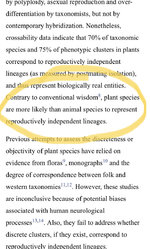Species was a concept that in a large part was first defined by the Carolus Linnaeus, in the 1700's. This is way before the understanding of inheritance. Linnaeus had cats and dogs and such in mind. Genetics, in animals has little tolerance for hybridizing between different species. Reproductive isolation is the norm. When you get into plants, it all falls apart. If you read botanical taxonomy, the whole "reproductive isolation" aspect of mammalian concept of species completely breaks down. And botanists are arguing about it constantly. The definition for plants, to the best of my knowledge is not significantly different from animals, with the recognition that natural interbreeding populations have a higher priority in defining species and reproductive isolation, as in a bear can not produce viable offspring with a moose, is a lower priority aspect of the definition in plants. In other words,
The fact that in captivity (on the farm or in the lab) 2 species of plants can produce viable hybrids is not important in the definition of species, what is important is whether the natural, undisturbed by humans, wild populations do not actually hybridize. So for example, genus Celtis, the hackberries, Celtis africanus and Celtis laevigata never cross breed in the wild. They exist on different continents, Africa and North America respectively. If one could force them to hybridize, this fact alone in botany does not negate their status as separate species.
Where as in oaks. Oaks in general hybridize easily. Quercus rubra - the northern red oak, and Quercus velutina, the eastern black oak, do in fact hybridize easily, and where their ranges overlap, there are all levels of intermediate forms. Here there is serious argument between different taxonomists as whether there are really 2 species or a single species. Along this line there is the concept of "super-species" where multiple species exist with overlapping ranges and freely hybridizing, whether this swarm constitutes separate species and associated hybrids or rather whether this should be treated as a single superspecies is an area of current debate. Similar with willows, Salix.
Botanical taxonomists spend a lot of time arguing with each other over what is a valid species and what is not. It simply is not "settled science". Very different than say the taxonomy of bird species. Where with birds, there are relatively few debates.
From Wikipedia:
In
biology, a
species is the basic unit of
classification and a
taxonomic rank of an
organism, as well as a unit of
biodiversity. A species is often defined as the largest group of
organisms in which any two individuals of the appropriate sexes or mating types can
produce fertile offspring, typically by
sexual reproduction. Other ways of defining species include their
karyotype,
DNA sequence,
morphology, behaviour or
ecological niche. In addition,
paleontologists use the concept of the
chronospecies since
fossil reproduction cannot be examined.

en.wikipedia.org


